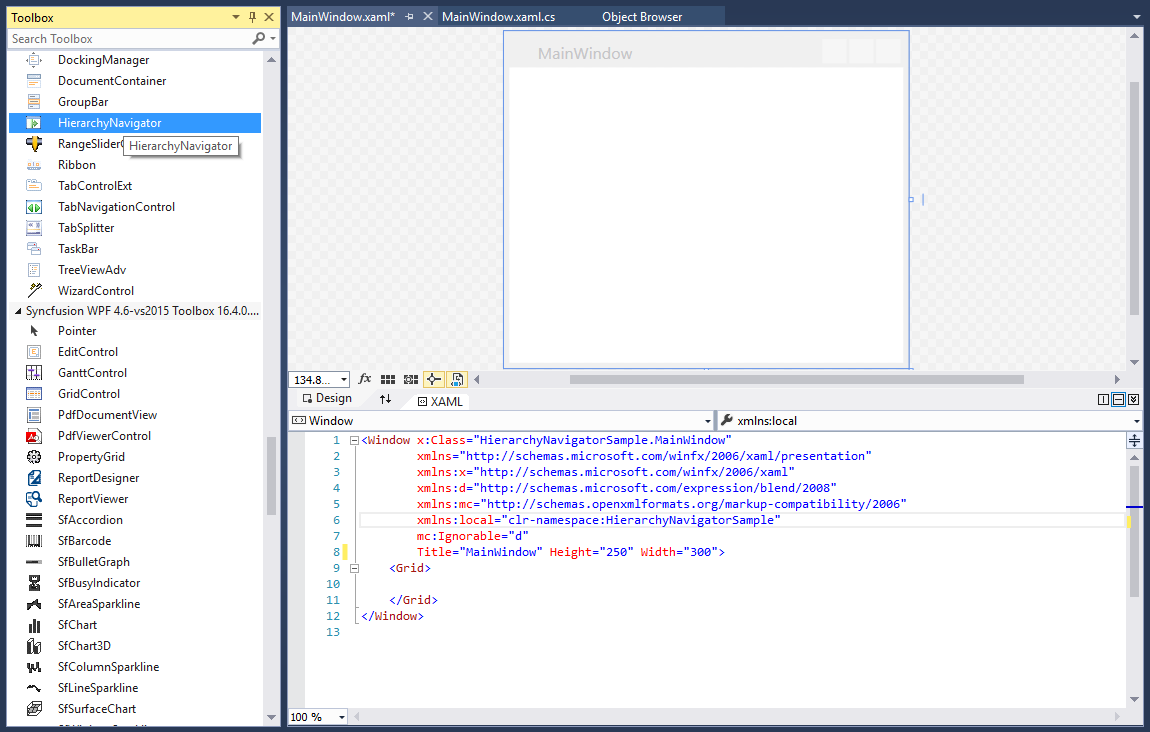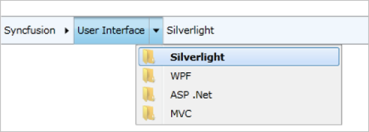Getting Started with WPF Breadcrumb (HierarchyNavigator)
18 Jun 20258 minutes to read
Assembly deployment
Refer to the control dependencies section to get the list of assemblies or NuGet package that needs to be added as a reference to use the control in any application.
You can find more details about installing the NuGet packages in a WPF application in the following link:
Create a simple application with HierarchyNavigator
You can create a WPF application with the HierarchyNavigator control using the following steps:
Create a project
Create a new WPF project in Visual Studio to display the HierarchyNavigator with functionalities.
Add control through designer
The HierarchyNavigator control can be added to an application by dragging it from the toolbox and dropping it into a designer view. The following required assembly references will be added automatically to the project:
- Syncfusion.Tools.WPF
- Syncfusion.Shared.WPF

Add control manually in XAML
To add the control manually in XAML, follow the given steps:
- Add the following required assembly references to the project:
- Syncfusion.Tools.WPF
- Syncfusion.Shared.WPF
- Import Syncfusion WPF schema http://schemas.syncfusion.com/wpf in the XAML page.
-
Declare the HierarchyNavigator control the in XAML page.
<Window xmlns="http://schemas.microsoft.com/winfx/2006/xaml/presentation" xmlns:x="http://schemas.microsoft.com/winfx/2006/xaml" xmlns:syncfusion="http://schemas.syncfusion.com/wpf" x:Class="HierarchyNavigatorSample.MainWindow" Title="HierarchyNavigator Sample" Height="350" Width="525"> <Grid> <!--Adding HierarchyNavigator control --> <syncfusion:HierarchyNavigator x:Name="hierarchyNavigator" Width="100" Height="100" VerticalAlignment="Center" HorizontalAlignment="Center"/> </Grid> </Window>
Add control manually in C#
To add the control manually in C#, follow the given steps:
- Add the following required assembly references to the project:
- Syncfusion.Tools.WPF
- Syncfusion.Shared.WPF
- Import the HierarchyNavigator namespace using Syncfusion.Windows.Tools.Controls;.
-
Create a HierarchyNavigator instance, and add it to the window.
using Syncfusion.Windows.Tools; namespace HierarchyNavigatorSample { /// <summary> /// Interaction logic for MainWindow.xaml /// </summary> public partial class MainWindow : Window { public MainWindow() { InitializeComponent(); //Creating an instance of HierarchyNavigator control HierarchyNavigator hierarchyNavigator = new HierarchyNavigator(); //Adding HierarchyNavigator as window content this.Content = hierarchyNavigator; } } }

Add items using HierarchyNavigatorItem
You can add the items inside the HierarchyNavigator control using HierarchyNavigatorItem.
<syncfusion:HierarchyNavigator x:Name="hierarchyNavigatorcontrol1" VerticalAlignment="Top" Height="30" Width="600">
<syncfusion:HierarchyNavigator.Items>
<syncfusion:HierarchyNavigatorItem Content="Syncfusion">
<syncfusion:HierarchyNavigatorItem.Items>
<syncfusion:HierarchyNavigatorItem Content="User Interface"/>
<syncfusion:HierarchyNavigatorItem Content="Silverlight">
<syncfusion:HierarchyNavigatorItem.Items>
<syncfusion:HierarchyNavigatorItem Content="Tools"/>
</syncfusion:HierarchyNavigatorItem.Items>
</syncfusion:HierarchyNavigatorItem>
</syncfusion:HierarchyNavigatorItem.Items>
</syncfusion:HierarchyNavigatorItem>
</syncfusion:HierarchyNavigator.Items>
</syncfusion:HierarchyNavigator>HierarchyNavigator hierarchyNavigator1 = new HierarchyNavigator() { Height = 30 };
HierarchyNavigatorItem hierarchyNavigatorItem1 = new HierarchyNavigatorItem();
hierarchyNavigatorItem1.Content = "Syncfusion";
HierarchyNavigatorItem hierarchyNavigatorItem11 = new HierarchyNavigatorItem();
hierarchyNavigatorItem11.Content = "User Interface";
HierarchyNavigatorItem hierarchyNavigatorItem111 = new HierarchyNavigatorItem();
hierarchyNavigatorItem111.Content = "Silverlight";
HierarchyNavigatorItem hierarchyNavigatorItem112 = new HierarchyNavigatorItem();
hierarchyNavigatorItem112.Content = "WPF";
HierarchyNavigatorItem hierarchyNavigatorItem113 = new HierarchyNavigatorItem();
hierarchyNavigatorItem113.Content = "ASP .Net";
HierarchyNavigatorItem hierarchyNavigatorItem114 = new HierarchyNavigatorItem();
hierarchyNavigatorItem114.Content = "MVC";
hierarchyNavigatorItem11.Items.Add(hierarchyNavigatorItem111);
hierarchyNavigatorItem11.Items.Add(hierarchyNavigatorItem112);
hierarchyNavigatorItem11.Items.Add(hierarchyNavigatorItem113);
hierarchyNavigatorItem11.Items.Add(hierarchyNavigatorItem114);
hierarchyNavigatorItem1.Items.Add(hierarchyNavigatorItem11);
hierarchyNavigator1.Items.Add(hierarchyNavigatorItem1);
this.Content = hierarchyNavigator1;Bind data
HierarchyNavigator accepts any business object collection to be bound to its ItemsSource property. Refer Data binding section for more details.
The steps to bind to a Business Object collection are as follows:
1. Create a class named HierarchyItem.
public class HierarchyItem
{
public string ContentString { get; set; }
public HierarchyItem(string content, params HierarchyItem[] myItems)
{
this.ContentString = content;
itemsObservableCollection = new ObservableCollection<HierarchyItem>();
foreach (var item in myItems)
{
itemsObservableCollection.Add(item);
}
HierarchyItems = itemsObservableCollection;
}
private ObservableCollection<HierarchyItem> itemsObservableCollection;
public ObservableCollection<HierarchyItem> HierarchyItems
{
get { return itemsObservableCollection; }
set
{
if (itemsObservableCollection != value)
{
itemsObservableCollection = value;
}
}
}
}2. Create a collection for ItemsSource to bind HierarchyItem.
public class HierarchicalItemsSource : ObservableCollection<HierarchyItem>
{
public HierarchicalItemsSource()
{
this.Add(new HierarchyItem("Syncfusion",
new HierarchyItem("User Interface",
new HierarchyItem("Silverlight"),
new HierarchyItem("WPF"),
new HierarchyItem("ASP .Net"),
new HierarchyItem("MVC")),
new HierarchyItem("Reporting Edition",
new HierarchyItem("IO"),
new HierarchyItem("PDF generator"),
new HierarchyItem("WPF")
)));
}
}3. In XAML, bind the collections to the ItemsSource property of the HierarchyNavigator control
<syncfusion:HierarchyNavigator Name="hierarchyNavigator2" Width="250" Height="25">
<syncfusion:HierarchyNavigator.ItemsSource>
<local:HierarchicalItemsSource />
</syncfusion:HierarchyNavigator.ItemsSource>
<syncfusion:HierarchyNavigator.ItemTemplate>
<HierarchicalDataTemplate ItemsSource="{Binding HierarchyItems}">
<TextBlock Text="{Binding ContentString}" Margin="2,0" />
</HierarchicalDataTemplate>
</syncfusion:HierarchyNavigator.ItemTemplate>
</syncfusion:HierarchyNavigator>
Theme
HierarchyNavigator supports various built-in themes. Refer to the below links to apply themes for the HierarchyNavigator,
